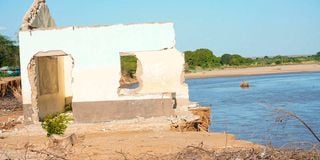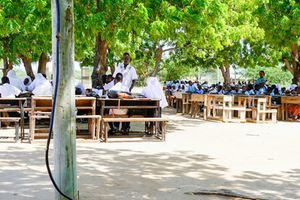How relentless River Tana swallowed villages and irreplaceable memories

Buildings that were once a part of Makere Primary School, drawn into River Tana on September 26, 2024.
What you need to know:
- Climate experts say Makere’s tragedy is a result of environmental degradation caused by reckless mining.
Esha Ziebi is still traumatised months after watching her house crumble into River Tana on one January morning.
“It was only a matter of time,” she says, having seen the river claim her neighbours’ homes in the days before.

Residents of Makere in Tana River County demolish their homes to save building materials after River Tana eroded the village.
“I told my husband the river was getting aggressive, and I advised we demolish the house and move to safety, but he refused,” she recalls.
That night, the danger became inescapable. As neighbours called to one another, warning of the river’s approach, it was just five meters away.
“It was a sleepless night,” she says. “The river was roaring, and nobody dared to sleep, fearing it would claim our lives.”

Esha Ziebi, a resident of Makere village in Tana River County during the interview at her home.
By dawn, six neighbouring houses were gone. By then, Esha’s house was barely standing on the river’s edge. She knew it wouldn’t last the day.
“I gathered some friends and with my husband’s permission, we began demolishing the house to save the iron sheets and other materials.” She moved her belongings to safety and began dismantling the structure, but before she could finish, the river claimed half the floor. By midday, she watched helplessly as her home was swept away.
The disaster left Esha impoverished, desperate and traumatised. Though she and her family have relocated 20 kilometres away to land allocated by the government, the losses still haunt her.
“I was used to electricity. Now I live in darkness, relying on firewood and candles for light. I am far from my friends, and there’s no access to clean water. It’s a real struggle to adapt,” she says.
Said Ramadhan, another resident, says the river has stolen irreplaceable memories. “Seven years ago, the river was eight kilometres away and this village was safe. Mango farms thrived, giving the place a cool atmosphere.”
“If anyone visited today, they would think we were chasing the river. But it’s the river that is claiming nearly all our livelihoods. We are poor now,” he says.
In less than five months, the village has lost the chief’s office, a shallow well, a madrassa, three-quarters of Makere Primary School, three ECDE classrooms, the school kitchen and a water tank.
Even as the county government allocates new land for survivors, the memories of their once beloved home remain etched in their minds.

Dr John Dhadho, a water and climate adaptation expert, during the interview in Makere Village.
Mwajuma Gamaharo, another resident, finds it difficult to adapt to the new environment. “I was used to tree shade. Now we live in open fields, cold and dusty. Our children are suffering from respiratory infections,” she says.
Her children also have to walk long distances to school when she can’t afford a boda boda.
“My life has changed from that of a farmer who depended on the river for food to a pastoralist struggling to survive,” she jokes, though her tone is bittersweet.
“Sometimes I feel like going back to my friends, but I have a family to take care of, so I stay.”

A water tank among other buildings that were once a part of Makere Primary School,drawn into River Tana.
The new Makere village is slowly developing, with residents adjusting to the difficulties of starting over. In Bandi village, residents faced a similar fate. After the river swallowed the entire area, they resettled along the Garsen-Garissa highway.
Abdi Bocha, an elder from Bandi, says starting anew is challenging but necessary. “We left all our amenities behind and settled in a place with none. It is tough, but we can’t go back. We have lost too much. We will adapt here—it’s just a matter of time.”
Makere and Bandi are two of 15 villages rebuilding their lives after facing the wrath of climate change. What remains are memories of cherished homes, now lost to nature’s fury. The serene environment, beautiful homes and safe spaces have vanished along with the graves of loved ones, claimed by the relentless river.
Dr John Dhadho, a climate adaptation expert, says Makere’s tragedy is a result of environmental degradation caused by reckless mining.
“River Tana was eight kilometres away from the village. The land was stable with hard rock until residents discovered they could make money from mining it. They allowed mining at a cost, and soon, all the hard rock that protected the village was gone,” he says.
In less than five years, the river began to stretch its banks, and the soil absorbed more water. “We warned the residents to leave the remaining rock intact to hold the river in check, but they didn’t listen. They mined it to the last bit.”
With the protective layer gone, the soil has eroded rapidly, increasing the river’s capacity each year. “Makere’s sandy loam soil is highly susceptible to erosion. The situation can only be controlled by constructing rocky gabions.”
Without urgent intervention, Dr Dhadho predicts that Makere has less than five years before it’s completely submerged. He also warns that Madogo town is next as all the hard rock there has been mined, leaving roads vulnerable to floods.
Already, River Tana has created a tributary through Madogo, five kilometres from the main road, claiming over 16 lives.
In response to the devastation, the government has committed to supporting flood survivors by providing building materials. ASAL Principal Secretary Kello Harsama announced the dispatch of iron sheets and timber for 7,000 households affected by the floods.
“This exercise is long overdue. It’s been nine months since these people started living in camps, and their shelters are no longer humane. We’re beginning the journey to help them rebuild decent homes,” he said.
The first phase will assist 1,000 households in Garsen, 700 in Galole, and 300 in Bura constituencies with materials for new homes.
Tana River Governor Dhadho Godhana said the county administration has mapped out new settlement areas. “We have identified 15 locations for new villages, and many residents have already moved. We are partnering with government and non-government organisations to fully support those affected.”
However, he urged residents to engage in environmental conservation efforts to prevent further land degradation.





